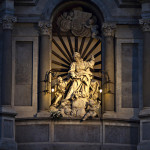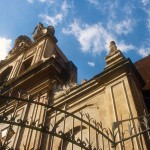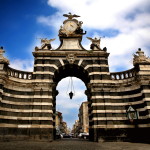St. Agatha on February 4th
- 22:00 h
- 8 KM
- Intermediate
Whether you are devoted or not, the meeting of the Patron Saint of Catania, S.Agata with her city will strike you with deep and heartfelt devotion. We, as CityMap Sicilia, take you along the places of worship and folklore of the procession of the fercolo of St. Agatha that you can’t miss during these days of celebration.
We suggest you to wear comfortable shoes and bring an essential backpack for this long day of celebration.
The path of St. Agatha on February 4th
On February 4th the festivities start at dawn. Since the early hours of the morning Piazza Duomo is filled with voices and excited faces. The white river of devotees awaits for a year this moment, which is repeated with the same rites and traditions. In the cathedral, at 6 am, the “Messa dell’Aurora” begins the unbroken journey of the patron saint through the streets of the city. Greeted by waving white handkerchiefs of the devotees, the reliquary bust of St. Agatha is carried on the shoulder along the nave of the Cathedral to be deposited on the fercolo that will accompany the saint through the streets of the city.
Day 4 is dedicated to the outside tour – or outside the walls. Starting from Piazza Duomo, the fercolo – pulled by the devotees thanks to two cords – heads towards the Archi della Marina “coming out” from the city through the Porta Uzeda. First stop at the votive shrine, known as Fontanella di S. Agata, with the offer of wax.
Preceded by the twelve” candelore”, the fercolo skirts the Archi della Marina and then reach the Train Station and Viale Libertà, until Via Umberto where the passage of Saint Agatha is marked by fireworks. It is already lunchtime and devotees do not stop, you can take advantage of the numerous bars to taste a local specialty and regain strength for the exciting stages that await you in the afternoon.
The Saint is about to walk the streets where the local market takes place every day, “a Fera”. With the cry of “Semu tutti devoti tutti”, the devotees accompany the fercolo through Piazza Carlo Alberto and then arrive in Piazza Stesicoro. Get ready for one of the most heartfelt moments of the day: salita (slope) of via Cappuccini. Here the saint retraces the places of her martyrdom, from the church of S. Biagio (also called the Fornace), to the church of S. Agata al Carcere, until reaching the Church of S. Agata La Vetere (first place of burial of the patroness ) where vespers are celebrated.
The procession of the fercolo of S. Agata continues in the streets of the popular neighborhoods. The fercolo goes to via Plebiscito until it reaches via Garibaldi, Piazza Risorgimento, and finally Piazza Palestro (and the Fortino) where a colorful fireworks greet the passage of the Patron Saint.
It is already night, the fercolo goes into the popular neighborhoods of S. Cristoforo and Angeli Custodi to end its external tour with the traditional “Calata della Marina” – the descent from via Plebiscito back to the port. But before returning to the cathedral, the fercolo and the candelore must overcome a last obstacle, go beyond the Archi della Marina. Under the watchful eye of devotees and citizens, delicate maneuvers are carried out to pass unscathed under the arch which is too low. The external tour of S. Agata ends with its return to the Cathedral.
Saint Agatha’s Cathedral (Duomo)
Saint Agatha’s Cathedral takes its name from the “Santuzza” protector of the city, her feast day is on February 5th. With its massive structure, the Cathedral has the characteristic contrast between the gray and white marble it’s used for the decorations.
Uzeda gate (porta Uzeda)
Uzeda gate connects the two parts of the old Clerks’ seminary, it was built in 1695 by the Duke of Camastra and was dedicated to the Viceroy Paceco Uzeda. It’s considered a symbol of the city and it is built in typical Catania baroque style: lava stone and white marble.
Port of Catania
Located in the centre of the Mediterranean Sea, the Port of Catania was first built in 1438. Repeatedly rebuilt over the centuries, today it is one of the most important ports in Sicily. With a total surface area of 615,000 m2, the Port is home to a variety of different activities
Piazza Carlo Alberto
Piazza Carlo Alberto takes its name from the Piedmontese King of the nineteenth century. It is located in the historical center of Catania. The baroque square, bordered by the Church of the Madonna of Carmelo and the Church of St. Gaetano alle grotte, is famous because hosts the popular market.
If you love typical markets, than the fair of Carlo Alberto square ("a fera") will satisfy your expectation.
Saint Blaise Church
St. Blaise Church it’s located in piazza Stesicoro, it overlooks on the Roman amphitheatre’s ruins. Even this construction, whose original structure dates back to 1098, was rebuilt in the eighteenth century after the earthquake of 1693.
The popular name of the Church is "carcarella", it means "small furnace".
Slope of via Cappuccini
“Cchianata de’ Cappuccini” is an important place during the celebrations in honour of Saint Agatha. It starts in via Cappuccini, near Piazza Stesicoro, and it continues with via Pietro Garofalo creating the form of a steep “S”. At the end of the slope there is via Santa Maddalena.
To be visited during the celebrations of St. Agatha, in February, to admire the rush of devotees.
Church of Saint Aghata in prison
It’s located in Piazza Santo Carcere, where, in the centre, flourishes the olive tree that is dedicated to one of the St. Agatha legend’s, to the east of the Spanish bastion (the rest of the Charles V’s walls) a short staircase leads to the Church of Saint Aghata in the Prison.
Porta Garibaldi (Garibaldi’s gateway)
At the end of Via Garibaldi there’s a triumphal arch, it was erected in 1768, mistakenly called “Gateway of Garibaldi” or “King Ferdinand’s one” (because it was built to celebrate the wedding between Prince Ferdinand IV and Maria Carolina of Austria) but it’s better known to people of Catania as “porta ‘o Furtinu”.







